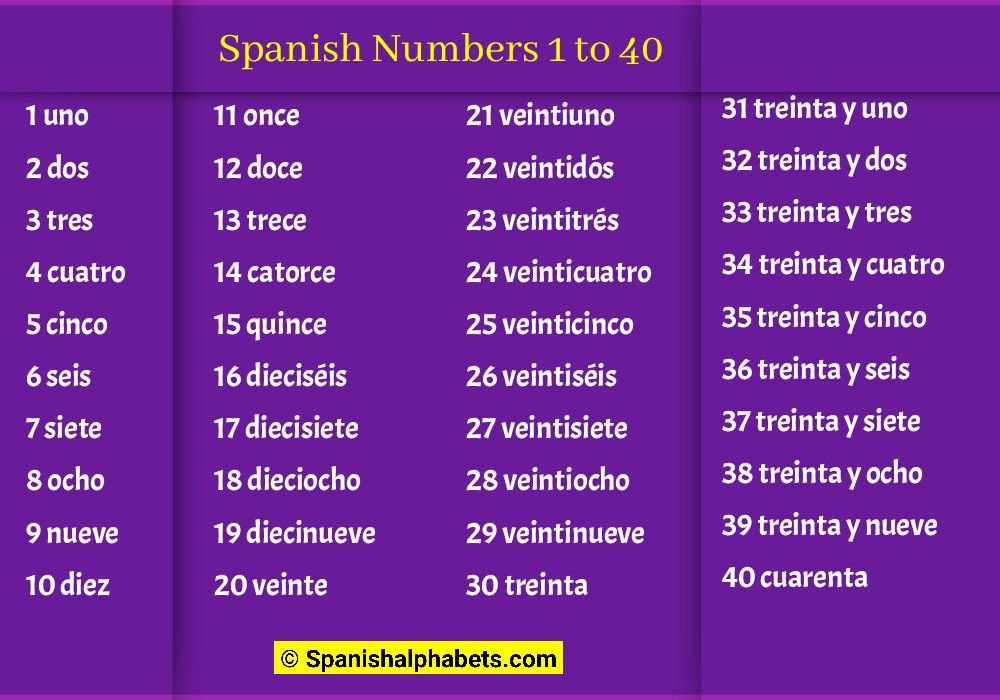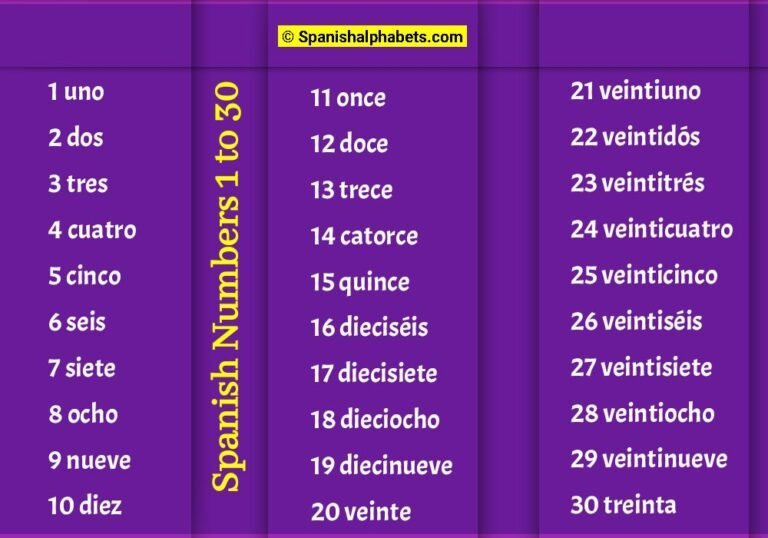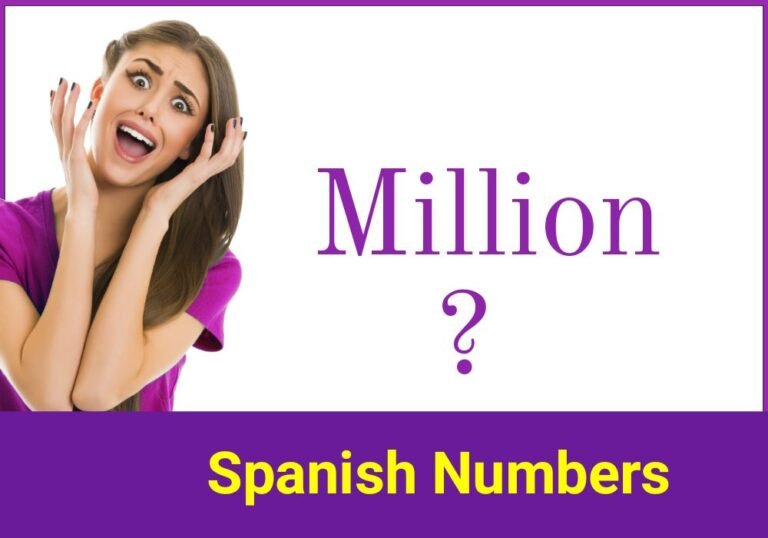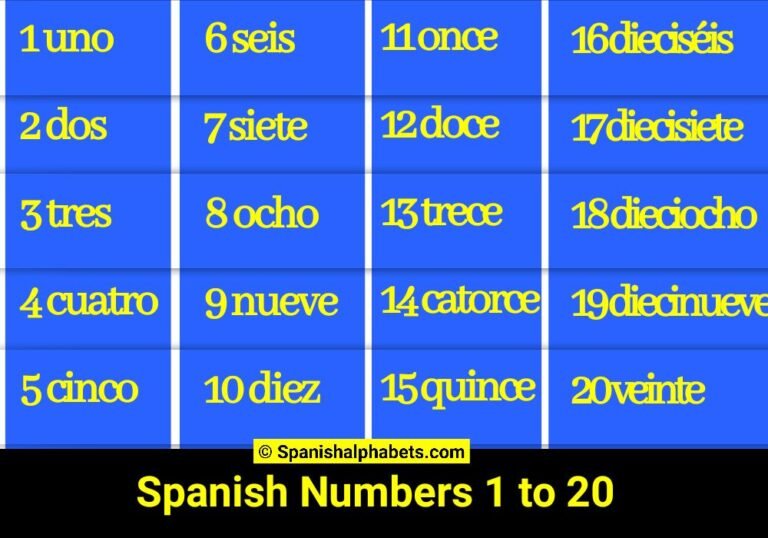If you’re looking for the best blog to help you learn the Spanish language, look no further than Spanishalphabets.com!
Not only will you find detailed explanations of how to pronounce each letter of the alphabet, but also tips on how to use them in conversation.
Plus, there are quizzes at the end of each lesson to test your knowledge. And once you’ve mastered the basics, move on to learning numbers – all the way up to 31!
Get ready to learn some more Spanish – we’re going up to 31! In this article, we’ll be looking at the numbers 1 to 31 in Spanish. By the end of this article, you’ll be able to count up to 31 in Spanish like a pro!
So, let’s get started! The first number we’ll look at is ‘uno’ (1). This is easy enough to remember, as it’s the same word in English. The next number is ‘dos’ (2), which again is similar to the English word.
After that, we have ‘tres’ (3), ‘cuatro’ (4), ‘cinco’ (5), and so on all the way up to ‘treinta y uno’ (31).
Pronunciation
| No. | Spanish | Pronunciation |
| 1 | uno | oo-no |
| 2 | dos | dose |
| 3 | tres | trace |
| 4 | cuatro | kwat-ro |
| 5 | cinco | sink-o |
| 6 | seis | saze |
| 7 | siete | see-yet-eh |
| 8 | ocho | och-o |
| 9 | nueve | new-eh-veh |
| 10 | diez | dee-ace |
| 11 | once | ohn-say |
| 12 | doce | dos-say |
| 13 | trece | treh-seh |
| 14 | catorce | ca-TOR-say |
| 15 | quince | KEEN-say |
| 16 | dieciséis | dee-AY-see-saze |
| 17 | diecisiete | dee-AY-see-see-AY-tay |
| 18 | dieciocho | dee-AY-see-och-o |
| 19 | diecinueve | dee-AY-see-new-EH-veh |
| 20 | veinte | Veh-een-tee |
| 21 | veintiuno | Veh-een-tee-oo-no |
| 22 | veintidós | Veh-een-tee-DOS |
| 23 | veintitrés | Veh-een-tee-TRACE |
| 24 | veinticuatro | Veh-een-tee-KWAT-ro |
| 25 | veinticinco | Veh-een-tee-SINK-o |
| 26 | veintiséis | Veh-een-tee-saze |
| 27 | veintisiete | Veh-een-tee-see-ay-tay |
| 28 | veintiocho | Veh-een-tee-OCH-o |
| 29 | veintinueve | Veh-een-tee-new-EH-veh |
| 30 | treinta | treh-een-tah |
| 31 | treinta y uno | treh-een-tah ee oo-no |
How to Say the Numbers 1-31 in Spanish
In Spanish, the numbers 1-31 are as follows: uno, dos, tres, cuatro, cinco, seis, siete, ocho, nueve, diez, once, doce, trece, catorce, quince, dieciseis, diecisiete, dieciocho, diecinueve veinte , treinta y uno.
- 1 uno
- 2 dos
- 3 tres
- 4 cuatro
- 5 cinco
- 6 seis
- 7 siete
- 8 ocho
- 9 nueve
- 10 diez
- 11 once
- 12 doce
- 13 trece
- 14 catorce
- 15 quince
- 16 dieciséis
- 17 diecisiete
- 18 dieciocho
- 19 diecinueve
- 20 veinte
- 21 veintiuno
- 22 veintidós
- 23 veintitrés
- 24 veinticuatro
- 25 veinticinco
- 26 veintiséis
- 27 veintisiete
- 28 veintiocho
- 29 veintinueve
- 30 treinta
- 31 treinta y uno.
To say these numbers in Spanish correctly, start by first saying the number corresponding to the number of tens. For example, “eleven” would be “diez y uno.
You always want to put the word “y” between the tens and unit digits when you say numbers in Spanish. So “twenty-one” in Spanish would be said as “venting.
How to spell Spanish numbers up to 31
Learning to spell Spanish numbers can be tricky, but it’s essential for anyone looking to learn the language. Here are some tips on correctly spelling Spanish numbers up to 31.
Remember that in Spanish, unlike English, the number 21 is not written as “veintiuno” but “veintiún.” This is because when a number ends in “-uno,” you must use the masculine form of “uno.”
uno, dos, tres, cuatro, cinco, seis, siete, ocho, nueve, diez, once, doce, trece, catorce, quince, dieciseis, diecisiete, dieciocho, diecinueve, veinte, veintiuno, veintidós, veintitrés, veinticuatro, veinticinco, veintiséis, veintisiete, veintiocho, veintinueve, treinta, treinta y uno.
The next thing to remember is that when spelling out numbers in Spanish, you always need to use feminine forms when the number ends in “-a.” For example, 31 would be written as “treinta y una,” not “treinta y uno.”
Why are Spanish numbers up to 31 crucial for American students?
Spanish numbers up to 31 are essential for American students because they provide a foundation for language learning. Spanish is the third most spoken language in the world, and understanding numbers is essential for communicating in any language.
In addition, Spanish numbers can be used to count in other languages, including French and Italian. Learning the numbers 1 to 31 in Spanish can help students better understand how to count in these languages.
The Spanish numbers up to 31 are essential for American students because they are used in many real-world situations. For example, when telling time, dates, prices, and phone numbers.
Students need to understand and use these numbers to communicate effectively in Spanish.
How to quickly learn Spanish numbers up to 31
Spanish numbers are relatively easy to learn and can be very useful in many everyday situations.
Here are some tips to help you quickly learn Spanish numbers up to 31.
- Start by learning the numbers 1-10. These are the most basic and essential numbers and will be used often in conversation.
- Once you know the numbers 1-10, you can learn the multiples 10 (20, 30, 40, etc.). These numbers follow a pattern that is easy to remember once you get the hang of it.
- To further practice your Spanish numbers, try writing them out in words. This will help familiarize you with the spelling of each number and reinforce what you have learned.
- Finally, don’t forget to practice using the numbers in context by incorporating them into conversations with native Spanish speakers.
Conclusion Points
If you’ve been following along with our series on learning Spanish numbers, congratulations—you’ve made it to the end! In this final installment, we’ll review everything we’ve learned and some common uses for numbers in Spanish.
By the time you’re done reading, you’ll be a pro at using numbers 1-31 in Spanish conversation.
So far in our series, we’ve learned how to say numbers 1-10, 11-20, and 21-30 in Spanish. We’ve also reviewed vital vocabulary words related to counting and discussing quantity.
In this final article, we’ll combine all that knowledge to help you understand how to use numbers 31 and below in everyday conversation.
FAQs
Welcome to Spanishalphabets.com’s FAQs section. You will find answers to some of the most commonly asked questions about learning Spanish here.
You can also ask questions in the comment box on this page. Our team of experts is always happy to help!
In addition, we offer a range of resources to help you learn Spanish numbers up to 31. With our help, you can confidently use Spanish numbers in no time!
Question (1) – How do you count to 31 in Spanish?
Answer: To count to 31 in Spanish, you first need to know 1-10. Once you know the numbers 1-10, you can count by tens to 30. To get to 31, you would then say “thirty-one.”
Question (2) – How do you say the number 22 in Spanish?
Answer: In Spanish, the number 22 is “veintidós.” This is because Spanish uses a base-10 number system, just like English.
In other words, each digit in a number represents 10 times the value of the digit to its right. So, in the number 22, 2 represents 20 (2 times 10), and 1 represents 1 (1 times 10).
Question (3) – How do you say 24 in Spanish?
Answer – In Spanish, the number 24 is referred to as “veinte cuatro.” This is said by combining the words for “twenty” and “four,” which are “veinte” and “cuatro,” respectively.
When saying this number out loud, it is typically pronounced with a slight emphasis on the syllable containing the number four.
Question (4) – How do you say 25 in Spanish?
Answer: The number 25 in Spanish is veinticinco. This can be broken down into constituent parts: veinti- (20) and -Cinco (5). Together, these make up the number 25.
Question (5) – How do you say 26 in Spanish?
Answer – To say the number 26 in Spanish, you would say “veintiséis.” This is because 26 is a composite number of 20 and 6.
In Spanish, when you have a composite number comprising a multiple of 10 and another number, you typically attach the two numbers. So, 26 would be read as “veinti” (20) + “séis” (6).
Question (6) – How do you say 27 in Spanish?
Answer – In Spanish, the number 27 is “veintisiete.” This word is derived from the Latin word “viginti,” meaning “twenty,” and the Spanish word “siete,” meaning “seven.
Question (7) – How do you say the number 28 in Spanish?
Answer – In Spanish, 28 is pronounced as “veintiocho.” This number is made up of two digits: 2 and 8. The number 2 is pronounced as “dos,” and the number 8 is pronounced as “ocho.
To say this number in Spanish, you would start by saying the word for “two” (dos), then adding the word for “eight” (Ocho) to the end.






